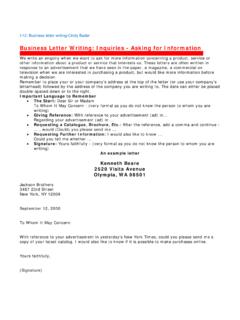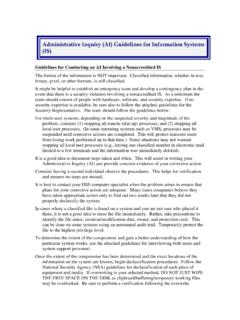Transcription of Step 3: Methods of enquiry - UNHCR
1 In OperationsStep 3: Methods of enquiry rotection risks faced by groups of women, girls, boys, and men of different ages and backgrounds can be complex and are often not very visible. Using the appropriate method of enquiry in a given situation is therefore crucial to identifying and understanding the underlying protection risks and the power different groups exercise over each other, including between women and men, which can lead to protection risks. enquiry for participatory assessment involves a process of listening, information gathering, and interactive analysis. Three Methods of information gathering and analysis are outlined below:16 Participatory observation and spot checks; Semi-structured discussions (or household discussions); Focus group discussions. Different Methods are appropriate in different contexts.
2 Focus groups are useful to explore group responses to a topic of common concern but inappropriate for sensitive topics such as personal accounts of Semi-structured discussions, or discussions at an individual or household level, are appropriate for obtaining more personal, detailed information and analysing problems that will not easily emerge in a group discussion; participatory observation and spot checks will provide complementary information to more in-depth P3in Operationsdiscussions and help visualize particular problems, to do with food distributions. If, during participatory observation, semi-structured, or focus group discussions with people of concern, sensitive issues emerge, or if team members feel that they need to find out more information about certain individual situations, they should discuss those subjects separately in a one-to-one setting with those individuals afterwards.
3 Multifunctional teams should draw up beforehand a schedule outlining which method they will employ as well as who will discuss with which subgroup of people of concern and which theme (see Annex 7 for an example). The number of meetings will vary depending on the method used and the time and number of team members available. Generally, offices should plan participatory assessment over a two to three week period. Focus group discussions should involve no more than 10 people at a time per discussion. When semi-structured discussions are held, one to five people should be involved (see below).Using different Methods at different times will allow teams to obtain various perspectives on the protection risks, to cross-check their understanding of them and to gather complementary information.
4 For example, they might organize a focus group to get women s perspectives on a specific protection risk, then talk to one or two women individually later to obtain more details, and then walk through the camp or urban area stopping here and there to ask a few questions to check how widespread the problem is. Comparing results from individuals and groups who represent the diversity of the community, using different Methods ( triangulation ), is an important means of checking the reliability of the information gathered during the assessment18 and of validating the team s understanding of the problem. 3in OperationsMethod 1: Participatory observation and spot checks Participatory observation is a way of looking at the situation or behaviour of people so as to compare it with what people report. It also presents a good opportunity to ask questions to persons of concern about how they use certain services, such as health, water, sanitation, etc.
5 And how they live their lives. It is a useful means of obtaining a better picture of the protection situation, particularly of aspects that are difficult for participants to verbalize. Observation can also help to put into context information provided by refugees. For example, refugees may have access to latrines, but a visit to them may reveal that they are unusable or dangerous for children. Participatory observation may uncover structural problems in the accessibility of services ( food distributions, health and police posts, behaviour of security guards controlling refugee access to UNHCR and implementing partner offices) or interpersonal behaviour/group dynamics within the community. For example, observation of a water-distribution point revealed that male community members kept order among the women and children collecting water by using a whip.
6 Observation sites can include playgrounds, classrooms, firewood collection areas, markets, transportation services in the case of repatriations, entrances to UNHCR offices, and queues for non-food items to check conditions and arrangements for older persons, pregnant women, etc. Observations can also be carried out at locations where partners deliver services, especially in urban areas, HIV counselling centres, childcare centres, schools. Spot checks and informal chats at distribution points or at any of the above sites may give a better idea of what individuals think about their situation (daily workload and challenges) and how they are organized. Combined with participatory observation, spot checks provide an opportunity to review the 3in Operationsdifferent roles assigned to women, girls, boys, and men in activities such as: Access to water distribution (who carries water and at what times); Food distribution (who scoops, who collects, who carries, who monitors, and at what times); Markets (who buys and who sells, who is overloaded with domestic chores); Firewood collection (who cuts, who collects and who carries); Latrines (size, usability by children, distance from homes); Schools (who attends, who does not, ratio of female/male teachers); Committees (what types, who participates, who speaks, who remains silent); Freedom of movement (who moves about, who does not); Health and community centres (who uses, who does not).
7 Documentation and assistance provided for at UNHCR /IP offices (who is informed, who collects). As staff often do not have access to observing people of concern at certain hours (early morning, at night) or in certain venues, it is important to seek innovative ways to observe or receive reliable descriptions of various aspects of people s 2: Semi-structured discussions Semi-structured discussions are conducted with a small number of people in an informal and conversational way by using open-ended questions. They can be conducted with individuals, families, households, or groups of people known 3in Operationsto each other and with similar concerns ( a small group of boys who are subject to forced military recruitment). Semi-structured discussions help provide detailed data often confidential about specific topics ( physical or domestic violence, exploitation, gender relations, forced recruitment).
8 In the process, teams may be able to clarify misinformation, identify gaps in communication channels, and discuss how to ensure access for all to information services, as well as to analyse specific risks and violations of rights in greater detail. Household discussions also present opportunities to visit refugees with disabilities or other house-bound refugees in their homes. Method 3: Focus group discussions A focus group is a group discussion which enables analysis and understanding of a selected topic on the basis of the common characteristics of the group (gender, age, ethnicity, socio-economic status, etc.). Meeting with groups of refugees together, under the guidance of a facilitator, is useful not only for gathering numerous views simultaneously, but also for observing the interchanges between and among different participants.
9 Like semi-structured discussions, focus groups, when conducted properly, can provide important qualitative information and an initial analysis of the protection risks faced by women, girls, boys, and men in the community, as well as the capacities and resources that exist within the community to enhance is important to conduct focus groups separately with women and men of all ages, starting from age 10 and up, because women, girls, boys and men of different ages and backgrounds experience both similar and different protection risks and can access and benefit from services and resources differently. Separate focus group discussions may also provide insights into cultural practices, traditional protection mechanisms and 3in Operationsother issues which may be affecting community members adversely and/or may offer opportunities to resolve longstanding problems by seeking guidance from the community on who can best address them.
10 Focus group discussions should be structured around a few key questions that can be adequately covered in the time period allotted (see Annex 3). A facilitator needs to remember that there is no right answer to a given question and that the discussion and disagreements among participants are as valuable and informative as the answers of particular individuals. 3



















